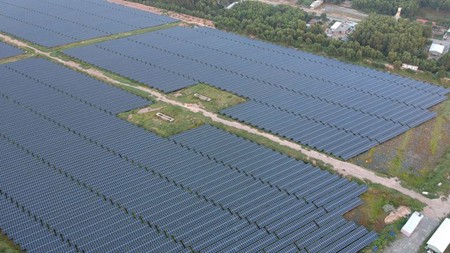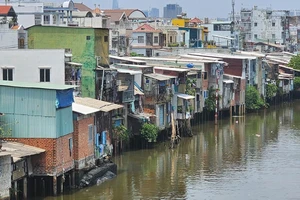
HCMC has a high and stable average monthly sunshine time of 100-300 hours. This makes it an ideal location to develop rooftop solar energy.
Statistics from the World Bank reveal that the rooftop solar energy potential of HCMC reaches around 6,300MW, larger than the current energy harnessing capacity of the city by 1.4 times. The installation of rooftop solar panels is not only effective in answering the needs of local residents but also useful in protecting the environment via the reduction of CO2 emission and thermal radiation.
In the period from 2013-2019, the installation of rooftop solar panels saw a significant increase citywide, particularly after the supporting policy issued by the Government. They are now spotted in both private houses and large business buildings.
In general, since the beginning of 2020, there have been over 6,400 solar panel systems developed citywide, having a capacity of 158.4MWp, accounting for 10.549 percent of the goal assigned by Vietnam Electricity. The revenues created from this amount has reached VND112.56 billion (approx. US$4.9 million).
It is estimated that in December 2020, the total capacity will be 241.13MWp.
Ms. Nguyen Thi Kim Anh from Tan Binh District shared that her household mounted 12 solar panels with the cost of VND70 million ($3,000), and has been able to save VND900,000 ($39) per month on her electricity bill. More importantly, this energy source is extremely stable, and even surplus for selling.
It seems solar energy development is a correct choice of HCMC.
Lately, the municipal authorities have focused on constructing waste-to-energy plants to turn garbage into power via incinerators.
At the moment, there are many projects to build factories to process solid waste and generate energy in turn. For example, Go Cat Trash-to-energy Plant has 3 generators to harness 2.4MW per day by creating 410m3 gas via high-density polyethylene material (HDPE). The total investment capital is around VND242 billion ($10.5 million).
Other to-be waste-to-energy plants are LFG Da Phuoc Power Plant, with a capacity of 12.36MW, built by Vietnam Waste Solutions (VWS); the 40MW power plant of Vietstar Jsc.; the 40MW power plant of Tam Sinh Nghia Co.; the 48MW power plant of TASCO. They are to be in operation in 2022-2023.
Vietnam Electricity – HCMC is now preparing to construct 110kV Phuoc Hiep – Cu Chi Electrical Substation to process the energy production from those new power plants.
Director of the HCMC Department of Natural Resources and Environment Nguyen Toan Thang shared that the city aims at decreasing the volume of household solid waste via sanitary landfill technologies as well as modern methods to harness energy from this trash, in accordance with the Government’s instruction.
This department is also cooperating with VWS to adjust treatment technologies to better cope with the current situation in HCMC. Firstly, VWS is going to directly install 70 mobile gas burners onto gas collection pipes on landfills to reduce greenhouse gas release.
In addition, HCMC is attracting investment in two trash-to-energy projects with a capacity of 1,000 tonnes per day per project, using the Public-Private-Partnership (PPP) model.
























